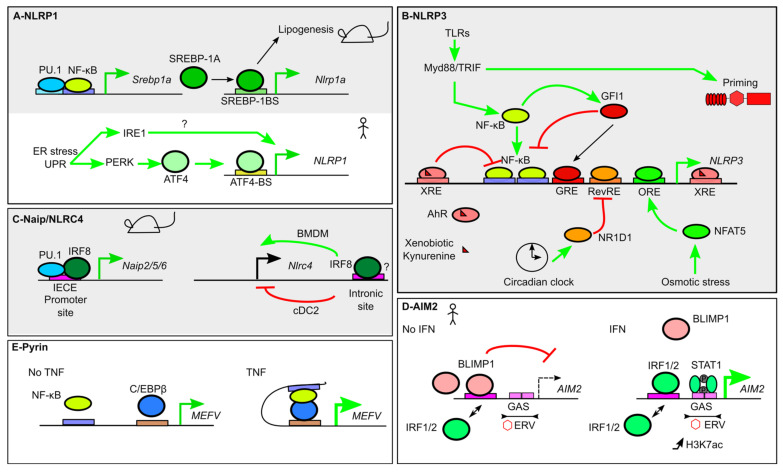Figure 2.
Transcriptional regulation of inflammasome sensors. (A) In mice (gray background), Nlrp1a expression is indirectly induced by Nuclear factor κB (NF-κB), which controls Srebp1a expression. SREBP1A couples Nlrp1a expression and lipogenesis. In humans, NLRP1 expression is induced by ER stress and the Unfolded protein response (UPR) and two of its effectors, Inositol-requiring enzyme 1 (IRE1) and PKR-like ER protein kinase (PERK). PERK induces Activating Transcription Factor 4 (ATF4) expression that directly upregulates NLRP1 expression. (B) NLRP3 expression is under the control of numerous TFs. NF-κB activation downstream of Toll-like receptors (TLRs) induces NLRP3 expression, while NLRP3 inflammasome priming is independent on transcription. GFI1 negatively regulates NLRP3 expression. GFI1 expression is inducible by NF-κB, thus creating a negative feedback loop. Xenobiotics and anti-inflammatory metabolites promote Aryl hydrocarbon receptor (AhR) binding to Xenobiotic Response Elements (XRE) that blocks NF-κB-mediated NLRP3 induction. Similarly, NLRP3 promoter integrates signals from the circadian clock regulator Nuclear receptor subfamily 1 group d member 1 (NR1D1) and from Nuclear factor of activated T cells 5 (NFAT5), which binds to an Osmotic Response Element (ORE), following osmotic stress. (C) Several Naip are regulated at steady state by Interferon Regulatory Factor 8 (IRF8), which binds Ets-Interferon Regulatory Factors (IRF) composite Element (EICE), together with PU.1. Binding of IRF8 in the intronic region of Nlrc4 controls positively or negatively Nlrc4 expression in bone marrow-derived macrophages (BMDM) and type 2 conventional dendritic cells (cDC2), respectively. (D) At steady state (left panel) AIM2 expression is repressed due to B lymphocyte-induced maturation protein-1 (BLIMP1) binding to an IRF/BLIMP1 composite site. In the presence of IFN-γ, IRF1/2 displace BLIMP1. Furthermore, Signal Transducer and Activator of Transcription 1 (STAT1) binding to GAS triggers AIM2 expression, which correlates with a local increase in H3K7 acetylation (H3K7ac). The tandem GAS sites are present in an endogenous retrovirus sequence (ERV). (E) Pyrin encoded by the MEFV gene is under the regulation of NF-κB. In the presence of Tumor necrosis factor (TNF), a chromatin loop favors NF-κB and CCAAT/enhancer binding protein β (C/EBPβ) interaction to upregulate MEFV expression.

